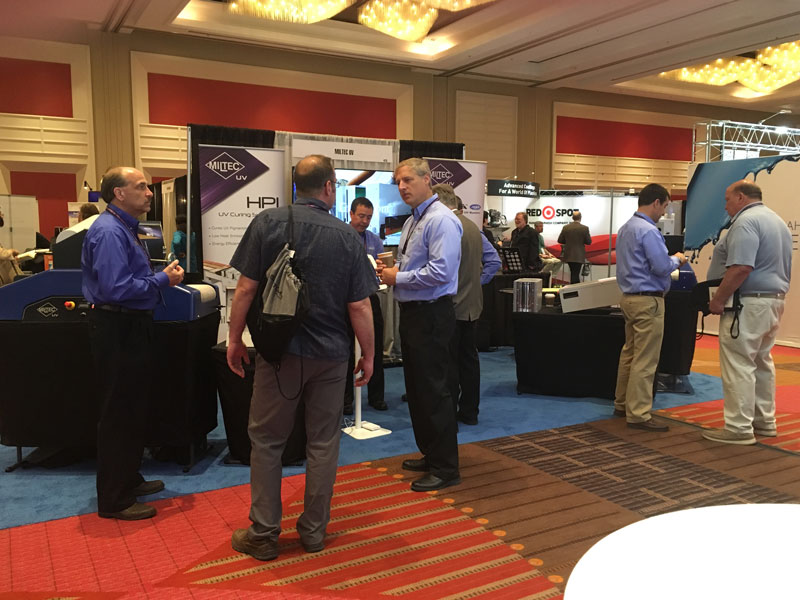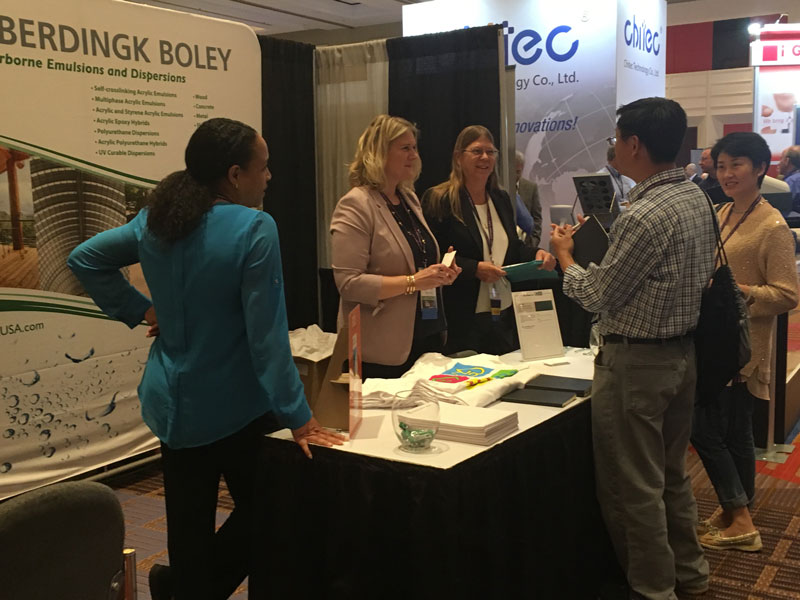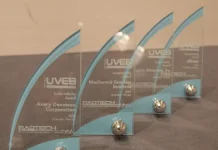By Nancy Cates, contributing editor, UV+EB Technology
Excellence in research, new technology, advanced materials and design were recognized at the RadTech 2018 Conference and Exhibition at the Hyatt Regency O’Hare, Chicago, Illinois, in May. The three-day event featured short courses; lively, cutting-edge topical panel discussions; an awards dinner; and a three-track technical conference with more than 100 presentations.
Educational opportunities cover vast spectrum of curing content
Two undergraduate-level short courses were offered. In Inkjet Surface Decoration, students learned about the transition to digital product decoration, marketing advantages, establishment of print quality requirements and challenges of the system, including capabilities, applications, trends and creation of new markets. The second, UV/EB Professional Short Course, was designed to familiarize UV/EB chemists and other technical professionals with the fundamentals of polymer chemistry.
Graduate-level short courses covered photopolymerization and click chemistry in radiation curing. Advanced Photopolymerization Topics included implications of pigments, radiation sources and environmental conditions on the product’s cure reaction and performance. Click Chemistry in Radiation Curing provided an in-depth discussion of chemical reactions and a generalized approach to molecular design and synthesis that has been adopted in the fields of chemical synthesis, biotechnology, materials science, drug discovery, surface science, and polymer synthesis and modification. The fifth short course was a Design of Experiments (DOE) presentation to help UV/EB scientists and engineers improve curing processes and formulations.
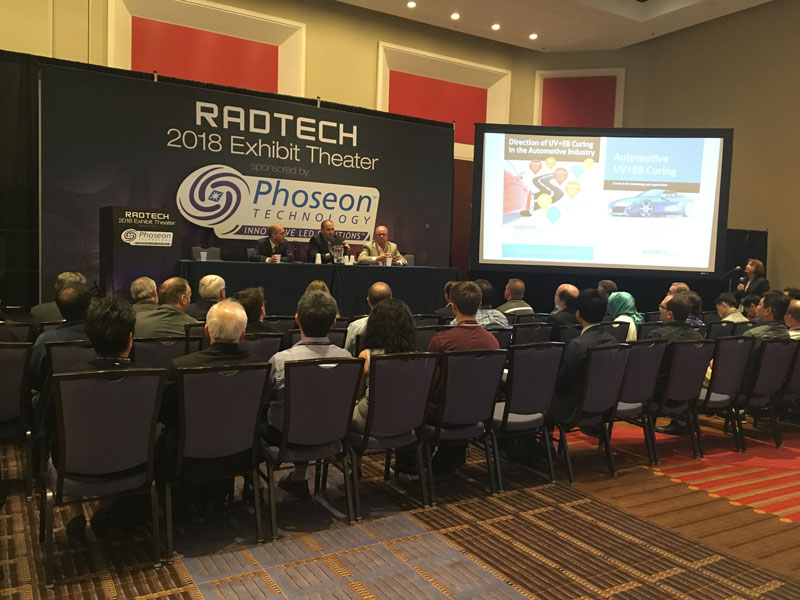 More than 80 companies exhibited on the tradeshow floor, which also included free presentations and panel discussions at the RadTech 2018 Exhibit Theater sponsored by Phoseon Technology. Session topics and panelists included the following:
More than 80 companies exhibited on the tradeshow floor, which also included free presentations and panel discussions at the RadTech 2018 Exhibit Theater sponsored by Phoseon Technology. Session topics and panelists included the following:
- Trends in UV Inkjet/Digital Printing – Tom Molamphy, Siegwerk; Alan Hudd, Alchemie Technology Ltd.; Josh Hope, Mimaki USA; and Josh Samuel, EFI.
- Future of UV LED Chemistry – Jake Staples, Ashland; Derrick Hemmings, Sun Chemical; John Kilbo; Siegwerk; Jo Ann Arceneaux, Allnex; Evan Benbow, Wikoff; and Jonathan Graunke; INX International Ink Co.
- Future of UVC LED – Sven Schalk, Heraeus; Jay Pasquantonio, Phoseon; Peter Barber, Sensor Electronic Technology, Inc.; Jim Cosman, Aquisense; Peter Gordon LiTeProducts LLC; and moderated by Robert Karlicek, Rensselaer Polytechnic Institute.
- UV+EB for Food Safety – Tatiana Koutchma, research scientist in Novel Food Processing, Agriculture and Agri-Food Canada, and Peter E. Gordon, manager, LiTeProducts, presenters and moderators; with panelists Peter Barber, Seoul Viosys Corporation; Keith Warriner, University of Guelph; and Anthony Popielarz, Vegetable Juices Inc.
- Future of Manufacturing and Customer Use in the Automotive Industry – Chris Seubert, Ford Motor Co.; David Fenn, PPG; Mary Ellen Rosenberger, BaySpring Solutions; and Jim Konen, UPS.
- Electron Beam for Packaging – featuring Vincent Luo, CGN Dasheng Electron Accelerator Technology Co. Ltd., and Kelly Williams, Futamura; with panelists Todd Fayne, Pepsico; Im Rangwalla, ESI; and Wang Ke, China Tobacco Zhejiang Industrial Co., Ltd.
- 3D Printing – Maximilian Zieringer, Formlabs; Mike Idacavage, Colorado Photopolymer Solutions; Jo Ann Arceneaux, allnex; Adam Steege, Trio Labs; and Josh Hope, Mimaki USA.
- UV LED Mythbusters – Mike Higgins, Phoseon; Jim Raymont, EIT; David Biro, Sun Chemical; and John Freismuth, Empire Screen Printing.
On Tuesday, attendees were treated to the President’s Reception, an awards dinner and presentations from the 2018 RadLaunch Accelerator Class, sponsored by Heraeus:
- Photopolymerizable, Remoldable Thermosetting Polymers – Brady Worrell, Dynamic Matter LLC
- Additive Manufacturing of Low-Density UV-Curable Resins to Produce Lightweight Structures for Automotive Applications – Matthew Pearlson, The Foam Printing Project
- Light-Enabled Orthopedic Casting and Splinting with PhotoCast – Joseph Lomakin, Reboot Medical
- Smart Composites for Additive Manufacturing: From Research to Market – Michele Tonizzo, moi composites
- Quantum Nano-Materials for Photocatalytic Applications – Nir Waiskopf, The Hebrew University of Jerusalem
- Metal 3D Printing for Precision High-Volume Production – Adam Steege, Trio Labs
- Transferrable Shadow Cure – Julie L. P. Jessop, University of Iowa.
New technology trends featured included the following:
- Hydrophilicity Enhancement of UV-Cured Acrylic Materials – Sivapackia Ganapathiappan, Boyi Fu and Ankit Vora, Applied Materials, Inc.
- Develop Functional Films and R2R Process – Nizamidin Jappar, Kimoto Tech Inc.
- Radiation Cured Parts: Impact of Semiconductor Wafer Cleaning – Ashwin Chockalingam and Rajeev Bajaj, Applied Materials, Inc.
- Use of High Refractive Index Materials in Display and Lighting Applications – Serpil Williams, Pixelligent Technologies, LLC.
The conference presentation schedule was divided into three tracks. Track A dealt with adhesion promotion/adhesives, automotive, 3D printing, printing/packaging, UV LED, photoinitiators, cationics and global markets. Track B included chemistry, overcoming challenges, flooring, photopolymer chemistry and patterning, coatings, formulation, waterborne, electron beam, equipment, applications and materials. Track C covered new products, photopolymerization fundamentals, competition/compliance, the Toxic Substance Control Act and safety of packaging inks.
Student poster contest winners
In partnership with the Technical Association of the Graphics Arts (TAGA), RadTech sponsored a student contest to tout RadTech 2018 and the benefits of UV/EB technology. Students from seven universities submitted posters, and RadTech crowd-sourced the voting.
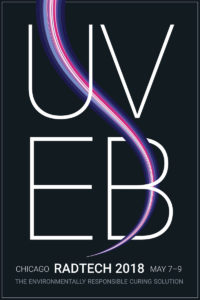 Olivia Blandford, from High Point University, High Point, North Carolina (first place, featured on the cover of this magazine). In sharing her inspiration for the poster, Blandford wrote: “Last summer while working for Miltec UV, I photographed UV bulbs attached to cold mirror reflectors. The purple color of the reflectors created such a beautiful array of colors, so when I decided to submit a poster for this contest, I wanted to recreate that same form of colorful light. I thought the blue and purple tones were a smart representation of the UV/EB industry, so I pulled specific colors from the original photograph and formed them into a simple, yet striking, line that catches the viewer’s eye and brings them downward as they read they entire poster.”
Olivia Blandford, from High Point University, High Point, North Carolina (first place, featured on the cover of this magazine). In sharing her inspiration for the poster, Blandford wrote: “Last summer while working for Miltec UV, I photographed UV bulbs attached to cold mirror reflectors. The purple color of the reflectors created such a beautiful array of colors, so when I decided to submit a poster for this contest, I wanted to recreate that same form of colorful light. I thought the blue and purple tones were a smart representation of the UV/EB industry, so I pulled specific colors from the original photograph and formed them into a simple, yet striking, line that catches the viewer’s eye and brings them downward as they read they entire poster.”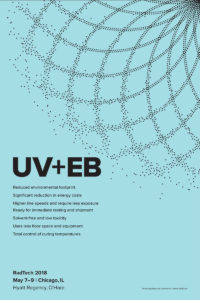 Ryan Hutson from California Polytechnic State University, San Luis Obispo (runner-up). He wrote: “Given that there are hundreds of applications for UV/EB-cured technology, I didn’t want to highlight just a few on the poster, rather an entire spectrum of applications, as depicted in the abstract graphic. The spectrum graphic is constructed through a series of particles, similarly to the curing process in which UV or EB comes into contact with a wet application and cures into a dry film or solid. I tried to illustrate this with the particles starting loosely then coming together to form a solid to represent the spectrum of applications.”
Ryan Hutson from California Polytechnic State University, San Luis Obispo (runner-up). He wrote: “Given that there are hundreds of applications for UV/EB-cured technology, I didn’t want to highlight just a few on the poster, rather an entire spectrum of applications, as depicted in the abstract graphic. The spectrum graphic is constructed through a series of particles, similarly to the curing process in which UV or EB comes into contact with a wet application and cures into a dry film or solid. I tried to illustrate this with the particles starting loosely then coming together to form a solid to represent the spectrum of applications.”
RadTech thanks Wandee Poolpol and Ray Verderber of Eckart, and David Biro of Sun Chemical for chairing this initiative.
Professionals, students honored with awards
Contributions to the development of emerging and novel ultraviolet and electron beam technologies were recognized at an awards dinner on Tuesday evening.
The best paper award went to Natasha Banke, INX International Ink Company, Edwardsville, Kansas, for “Residual building block chemicals in raw materials and finished printing inks – A risk assessment approach to manufacturing and detection limits,” included in this issue on page 14.
Also earning awards for emerging technology were the following:
- MicroTau Pty. Ltd., New South Wales, Australia, for their low-cost, printed “sharkskin” surface, demonstrated to reduce drag and improve efficiency for airplanes, cars, other vehicles and wind turbines; as well as to provide biocide-free antifouling materials for marine vessels, antibacterial surfaces in hospitals and aircraft tray tables, and self-cleaning paints and microfluidic devices.
- Lumii Inc., Boston, Massachusetts, for enabling hologram-like imagery using standard presses, media and inks for security and brand protection. The work is achieved by applying sophisticated terascale computation to model billions to trillions of light rays as they interact with high-resolution printed material, disrupting many of the conventions associated with traditional security devices (See page 10).
- DENTSPLY Sirona, York, Pennsylvania, for its patented antimicrobial/antibacterial resins that can be readily formulated in a variety of compositions, such as composites, adhesives, sealants and coatings to provide high-performance, nonleaching active surfaces to kill a wide range bacterium and also potentially could be used to ease biofilm removal.
- LiTeProducts LLC, New York, New York, for Adaptive Lighting, which mixes multi-wavelength, multitasked UV LEDs with visible-light LEDs for novel germicidal and 3D curing. Potential applications include leafy green vegetable sanitation and freshness preservation as well as sanitation of water, air and the surface of objects with an added UV-printed verification of sanitation.
Forough Zareanshahraki and her adviser, Vijay Mannari, of Eastern Michigan University, earned the award for best student technology paper for “‘Green’ UV LED Gel Nail Polishes from Bio-Based Materials.” They and their team from Eastern Michigan’s Coatings Research Institute also received a special student award for emerging technology. To create the “green” gel, they synthesize novel polymers from bio-renewable materials such as oils from soybeans, corn or canola; itaconic acid; gum rosin; and bio-based succinic acid.



